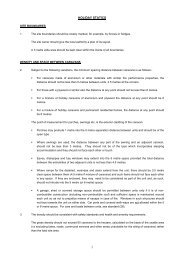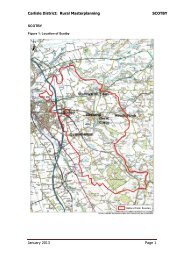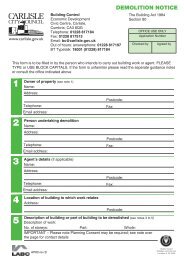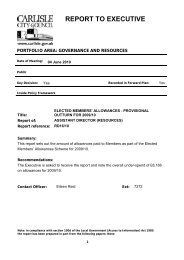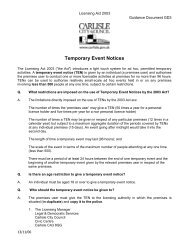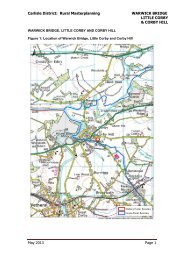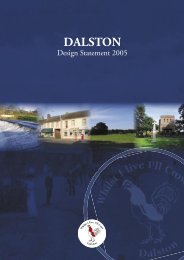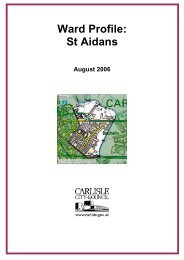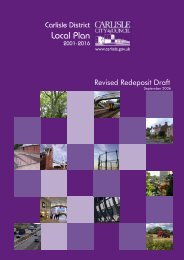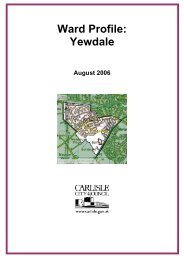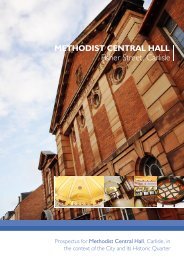Download the Management Plan - Carlisle City Council
Download the Management Plan - Carlisle City Council
Download the Management Plan - Carlisle City Council
Create successful ePaper yourself
Turn your PDF publications into a flip-book with our unique Google optimized e-Paper software.
Watercourses<br />
Outflow<br />
Hell Beck runs out through <strong>the</strong> north eastern side of <strong>the</strong> Tarn and joins <strong>the</strong> River Gelt fur<strong>the</strong>r<br />
downstream. A small sluice gate is operated on this stream but has only minimal effects when<br />
water left is high enough. The stream regularly runs dry in <strong>the</strong> summer months if <strong>the</strong> Tarn level<br />
is low from evaporation and lack of rain. The aim of raising <strong>the</strong> water level if possible at times<br />
(by preventing loss out of <strong>the</strong> stream) is to increase water depths for <strong>the</strong> boat launching areas. At<br />
o<strong>the</strong>r times lower water levels can be encouraged by opening <strong>the</strong> sluice gate. This could be to<br />
help encourage marginal vegetation growth which might o<strong>the</strong>r wise become swamped. It also<br />
helps to prevent as much bank erosion. At this time it is not deemed necessary for more control<br />
of <strong>the</strong> water levels. Although this may need to be reviewed in <strong>the</strong> future depending on rainfall<br />
levels.<br />
Hell beck is regularly cleared of debris and vegetation to keep it open. This is done in stages with<br />
a different section being cleared each year currently by hand but <strong>the</strong>re is <strong>the</strong> potential to clear<br />
sections by mechanical means on rotation such as a 50m stretch each year. Where Hell Beck<br />
leaves sluice wood it is fenced on one side until it meets <strong>the</strong> ditch on <strong>the</strong> boundary. From here it<br />
is only fenced on <strong>the</strong> far side which forms <strong>the</strong> neighbours boundary.<br />
Inflow<br />
The banks of <strong>the</strong> inlet at wildlife bay, that drains from Farlam Meadow is an important area for<br />
nor<strong>the</strong>rn marsh orchid with over 25 spikes counted in 2009.<br />
The second inlet comes in from neighbouring farmland and enters near <strong>the</strong> bird hide.<br />
Action<br />
Maintain sluice gate in current basic working condition<br />
Continue rotational clearing of hell beck to keep watercourse open<br />
Clear inlet streams as required.<br />
Marsh & Wet Areas<br />
Farlam meadow contains <strong>the</strong> largest wet grass area, holding water year round. A causeway was<br />
built over part of this area to prevent damage from <strong>the</strong> public footpath that runs across it.<br />
A valuable wetland vegetation community has developed and this status should be maintained.<br />
The drier sections of this meadow are grazed under licence by a neighbouring farmer. O<strong>the</strong>r wet<br />
areas have developed by <strong>the</strong> boundary ditch that runs from level with Roman wood along 2 field<br />
lengths until it reaches <strong>the</strong> road to Talkin village. These valuable wet areas are in a quiet area of<br />
<strong>the</strong> Tarn. The main threat is from trampling from <strong>the</strong> sheep that graze <strong>the</strong>se fields and require<br />
access to <strong>the</strong> water.<br />
Species <strong>Management</strong><br />
Species lists for Flora, Fauna, Fungi, Odonata, Butterflies, Fish are kept in <strong>the</strong> site office. Copies<br />
of all o<strong>the</strong>r surveys undertaken are also kept in <strong>the</strong> site office.<br />
Mammals<br />
Talkin Tarn has small range of fauna, none of which are currently managed specifically for. The<br />
badger set is however purposely left as an area of no intervention and public access is not<br />
encouraged. The most red squirrels seen at any one time is 6 during 2009. Grey squirrels have<br />
regularly been seen passing through <strong>the</strong> area and are being managed as necessary. A bat survey<br />
30



